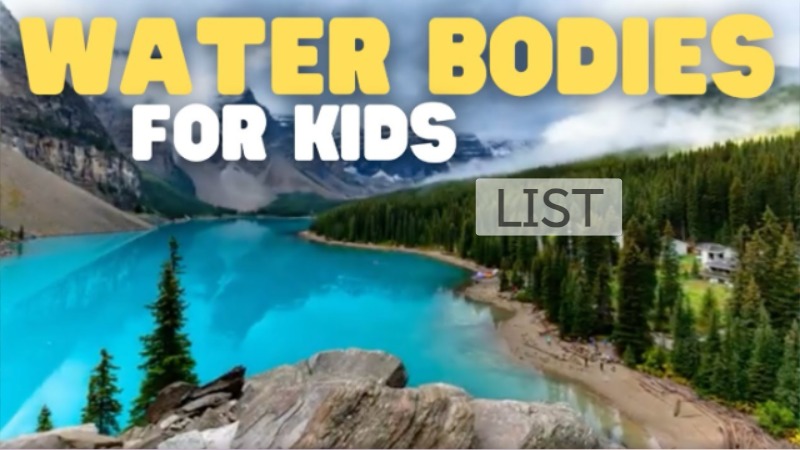
Bodies of Water List for kids with explanation, check names of different types of water bodies in the world. Bodies of water refer to large accumulations or expanses of water found on the Earth’s surface. They can be categorized into various types based on their size, characteristics and geographical location. Some common types of bodies of water includes ocean, sea, river, lake, pond, canal among others.
Each type of body of water has unique characteristics, ecological significance, and human uses, contributing to the diverse and interconnected nature of our planet’s water systems.
Bodies of Water List for Kids
The most commonly recognized bodies of water for kids includes the following:-
Oceans
The oceans are vast bodies of saltwater that cover about 71% of the Earth’s surface. This huge body of water play a crucial role in the planet’s climate regulation, providing habitat for countless marine species, and supplying resources and food for human populations. Here are some key points about the oceans:-
- Importance: Oceans are essential for maintaining the Earth’s climate balance. They absorb and store large amounts of heat, which helps regulate global temperature. They also act as a carbon sink, absorbing about one-third of human-generated carbon dioxide emissions, which helps mitigate the impact of climate change.
- Composition: Oceans are made up of saltwater, with an average salinity of around 3.5%. The primary elements dissolved in seawater are sodium and chloride, which combine to form salt.
- Major Oceans: There are five recognized major oceans on Earth:
- Pacific Ocean: It is the largest and deepest ocean, covering about one-third of the Earth’s surface.
- Atlantic Ocean: It is the second-largest ocean and separates the Americas from Europe and Africa.
- Indian Ocean: It is the third-largest ocean and is located between Africa, Asia, and Australia.
- Southern Ocean: This ocean surrounds Antarctica, and its boundaries were officially established in 2000.
- Arctic Ocean: It is the smallest and shallowest of the five oceans and is located around the North Pole.
- Marine Life: The oceans are teeming with diverse marine life, ranging from microscopic organisms to massive creatures like whales. Coral reefs, which are found in tropical waters, are among the most diverse and productive ecosystems on the planet. Oceans also support various fisheries that provide a significant source of food for human populations.
- Human Interaction: Oceans have played a vital role in human history and continue to be essential for transportation, trade, and exploration. Coastal regions are heavily populated, and many communities depend on the ocean for their livelihoods through fishing, tourism, and offshore industries such as oil and gas extraction.
- Threats and Conservation: Oceans face numerous challenges, including overfishing, pollution, habitat destruction, and climate change. These issues harm marine ecosystems, disrupt food chains, and threaten the survival of many species. Efforts are being made worldwide to protect and conserve the oceans, including the establishment of marine protected areas, sustainable fishing practices, and reducing plastic pollution.
It’s important to recognize the significance of the oceans and work together to ensure their long-term health and sustainability for future generations.
Sea
The term “sea” generally refers to a large body of saltwater that is partially enclosed by land. It is a broader term compared to “ocean” and can include smaller bodies of saltwater such as the Mediterranean Sea or the Red Sea. Here are some key points about seas:-
- Definition: Seas are typically partially enclosed by land, although they may have connections to the open ocean. They are generally smaller in size compared to oceans and can vary in shape, depth, and salinity.
- Formation: Seas can form through various processes, including tectonic activity, where movements in the Earth’s crust create depressions that become filled with water. They can also result from the flooding of coastal areas due to rising sea levels or the formation of barrier islands.
- Examples: There are numerous seas around the world, each with its own unique characteristics. Some well-known seas include the Mediterranean Sea, the Red Sea, the Caribbean Sea, the South China Sea, and the Baltic Sea. These seas often have distinct ecosystems, maritime boundaries, and cultural significance.
- Salinity: The salinity of seas can vary depending on factors such as evaporation rates, freshwater inputs from rivers, and the exchange of water with the open ocean. Some seas, like the Dead Sea, have high salinity due to intense evaporation, while others, such as the Baltic Sea, have lower salinity due to significant freshwater inputs.
- Human Interaction: Seas have been important for human civilization throughout history. They have served as transportation routes, facilitated trade and exploration, and provided valuable resources like fish and minerals. Coastal communities often rely on seas for livelihoods, tourism, and recreational activities.
- Environmental Concerns: Seas face various environmental challenges similar to oceans, including pollution, overfishing, habitat destruction, and climate change. These threats can have significant impacts on marine ecosystems and the well-being of coastal communities. Conservation efforts, including the establishment of marine protected areas and sustainable fishing practices, are crucial to mitigate these challenges.
Overall, seas play a vital role in the Earth’s geography, human activities, and ecological systems. They are interconnected with oceans and have their own unique characteristics and significance in different regions of the world.
Lake
A lake is a large body of water that is typically freshwater and surrounded by land. Unlike seas and oceans, lakes are generally not connected to the open ocean and are often found inland. Here are some key points about lakes:-
- Formation: Lakes can form through various geological processes. They can result from glacial activity, where ice sheets carve out depressions that fill with water when the glaciers melt. Lakes can also form in volcanic craters, tectonic basins, or through human-made activities such as damming rivers.
- Freshwater: Most lakes contain freshwater, which means the water is relatively low in salinity. However, some lakes, like the Great Salt Lake in Utah, can have high salinity due to evaporation and the concentration of minerals.
- Size and Depth: Lakes can vary significantly in size, ranging from small ponds to vast bodies of water. They can also vary in depth, with some lakes being relatively shallow while others are very deep. For example, Lake Baikal in Russia is the deepest lake in the world, reaching depths of over 1,600 meters (5,249 feet).
- Biodiversity: Lakes support diverse ecosystems and are home to various plants and animals. They can host a range of aquatic organisms, including fish, amphibians, reptiles, invertebrates, and a variety of aquatic plants. Lakes also provide habitats for birds and other animals that depend on them for food and shelter.
- Human Uses: Lakes have been important for human societies throughout history. They serve as sources of freshwater for drinking, irrigation, and industrial use. Lakes are often used for recreational activities such as boating, swimming, fishing, and tourism. They can also play a role in transportation and as reservoirs for hydroelectric power generation.
- Environmental Concerns: Lakes face environmental challenges, including pollution from human activities, invasive species that disrupt native ecosystems, and eutrophication (excessive nutrient enrichment) that can lead to harmful algal blooms. Climate change can also impact lakes through changes in temperature, precipitation patterns, and water availability.
It’s important to manage and protect lakes to ensure their water quality, ecological balance, and sustainable use for both humans and wildlife. Conservation efforts, watershed management, and responsible water use practices are essential for maintaining the health and biodiversity of lakes.
Pond
A pond is a small body of water that is typically shallow and often found in a natural or artificial depression on land. It is similar to a lake but is generally smaller in size. Here are some key points about ponds:-
- Size and Depth: Ponds are smaller in size compared to lakes, ranging from a few square meters to a few hectares in area. They are usually shallower than lakes, with average depths ranging from a few centimeters to a few meters.
- Formation: Ponds can form through various natural processes. They can be created by geological activities, such as glacial activity, where depressions are left behind after the retreat of glaciers. Ponds can also form in low-lying areas with poor drainage or in depressions created by animal activity or fallen trees. Additionally, humans can create artificial ponds for various purposes, such as irrigation, water storage, or ornamental features in gardens.
- Freshwater: Most ponds are freshwater ecosystems, meaning they contain water with low salinity. They are usually fed by rainwater, groundwater, or small streams. However, there are some ponds with high salinity levels, such as saline or salt ponds, where water salinity is elevated due to evaporation or geological factors.
- Biodiversity: Ponds support a diverse range of plant and animal life. They provide habitats for various aquatic organisms, including insects, frogs, turtles, fish, and a variety of aquatic plants. Ponds also attract birds and other animals that rely on them for food, water, and shelter. Due to their smaller size, ponds often have distinct and localized ecosystems.
- Human Uses: Ponds have been used by humans for various purposes throughout history. They can be used for agricultural irrigation, livestock watering, and aquaculture. Additionally, ponds can be created or modified to serve ornamental purposes in gardens, parks, or estates.
- Environmental Concerns: Ponds can face environmental challenges similar to larger water bodies. They can be affected by pollution from nearby agricultural or urban areas, invasive species that disrupt the native ecosystem, and changes in water quality or temperature due to human activities or climate change. Proper management and conservation practices are important to maintain the health and ecological balance of ponds.
Ponds are valuable ecosystems that provide essential habitats for many organisms and contribute to the overall biodiversity of an area. They offer opportunities for recreation, education, and scientific study, and their conservation is crucial for the well-being of both the surrounding environment and human communities.
River
A river is a natural flowing watercourse that moves water from higher elevations to lower elevations. It is a significant feature of the Earth’s landscape, and rivers play a vital role in shaping the environment and supporting various ecosystems. Here are some key points about rivers:-
- Formation: Rivers typically form through the accumulation and flow of water from various sources, such as rainfall, snowmelt, or underground springs. The water collects in streams or channels, which then merge to form larger rivers. Rivers can also be fed by glaciers, lakes, or other rivers.
- Flow and Drainage: Rivers flow downhill due to gravity, carrying water and sediment along their course. They eventually drain into larger bodies of water, such as lakes, seas, or oceans. The area of land drained by a river and its tributaries is called a watershed or river basin.
- Features: Rivers have distinct features along their course. These include source (the starting point of a river), mouth (where it empties into another water body), meanders (bends or curves in the river’s path), rapids (fast-moving, turbulent stretches of water), and waterfalls (vertical drops in the river’s elevation).
- Erosion and Sedimentation: Rivers have the power to erode the land they flow through, carrying away soil, rocks, and sediments. Over time, rivers can create valleys, canyons, and deltas through erosion and deposition of sediment. The sediment carried by rivers is often deposited at their mouths, contributing to the formation of fertile floodplains.
- Ecosystems and Biodiversity: Rivers support diverse ecosystems and provide habitats for a wide range of plants and animals. They are home to numerous aquatic species, including fish, amphibians, reptiles, invertebrates, and various types of vegetation. Riparian zones, which are the areas adjacent to rivers, are important habitats for many terrestrial species as well.
- Human Uses: Rivers have been crucial for human civilizations throughout history. They provide a source of freshwater for drinking, irrigation, and industrial purposes. Rivers have facilitated transportation and trade, serving as major trade routes in the past. They are also harnessed for hydroelectric power generation, recreation, and tourism.
- Environmental Concerns: Rivers face several environmental challenges due to human activities. Pollution from industrial and agricultural runoff, dam construction, water diversion, and over-extraction of water can impact river health and biodiversity. Maintaining water quality, protecting riparian habitats, and ensuring sustainable water management are important for the conservation of rivers.
Rivers are dynamic and essential features of our planet. They shape the landscape, provide valuable resources, support ecosystems, and play a crucial role in human societies. Sustainable management and conservation practices are crucial to preserve the health and integrity of rivers for current and future generations.
Lagoon
A lagoon is a shallow body of water that is separated from the open ocean or sea by a barrier, such as a sandbar, coral reef, or barrier island. It is typically found along coastlines and can have a range of sizes and characteristics. Here are some key points about lagoons:-
- Formation: Lagoons form in coastal areas where a barrier, such as a sandbar or coral reef, separates the lagoon from the open ocean or sea. These barriers can be created through natural processes, such as sediment deposition, or by human-made structures, like breakwaters or jetties. Lagoons can also form when a bay or estuary becomes partially enclosed by a barrier.
- Characteristics: Lagoons are characterized by their shallow depth and calm, relatively sheltered waters. They are usually shallower than nearby open ocean areas and can have varying salinity levels, depending on factors such as freshwater inputs from rivers or groundwater. The water in lagoons is often clearer and more tranquil compared to the rougher conditions of the open ocean.
- Ecosystems: Lagoons support unique and diverse ecosystems. They provide habitats for a wide range of marine organisms, including fish, shellfish, seagrasses, and other types of vegetation. Lagoons often serve as important nursery grounds for various species, offering protection and a source of food. They can also support bird populations and other wildlife that rely on lagoon habitats.
- Human Uses: Lagoons have been utilized by humans for various purposes throughout history. They can be used for recreational activities, such as swimming, boating, and snorkeling. Lagoons also provide opportunities for fishing, aquaculture, and tourism. Their calm and picturesque settings make them popular destinations for resorts and leisure activities.
- Environmental Concerns: Lagoons face several environmental challenges. They can be vulnerable to pollution from coastal development, agricultural runoff, and other human activities, which can negatively impact water quality and the health of the ecosystem. Climate change, including rising sea levels and increased storm intensity, can also pose threats to lagoons by altering their hydrology and causing erosion.
- Conservation and Management: Protecting and managing lagoons is important for preserving their ecological integrity and the services they provide. Conservation efforts may include the establishment of marine protected areas, monitoring and regulation of human activities, and implementing sustainable practices to minimize pollution and habitat degradation.
Lagoons are valuable coastal features that offer unique ecosystems and recreational opportunities. Balancing human use with conservation efforts is essential to ensure the long-term sustainability of lagoons and the preservation of their biodiversity and ecological functions.
Glacier
A glacier is a large mass of ice that forms over long periods of time from accumulated snowfall and moves slowly downhill under the influence of gravity. Glaciers are significant features of Earth’s cryosphere (frozen water) and have a profound impact on the landscape. Here are some key points about glaciers:-
- Formation: Glaciers form in areas where snowfall exceeds snowmelt over many years. As new snow accumulates, it compresses the underlying layers, transforming the snow into dense ice. This process is called “glacial ice.” Over time, the weight of the ice causes it to flow downhill.
- Types of Glaciers: There are two main types of glaciers: valley glaciers and ice sheets. Valley glaciers form in mountainous regions and flow down valleys, while ice sheets cover vast areas and can be found in polar regions, like Antarctica and Greenland.
- Movement: Glaciers move due to the combined effects of gravity and the internal deformation of the ice. The ice at the base of the glacier is under immense pressure and behaves like a viscous fluid, allowing the glacier to slowly flow downhill. The speed of glacier movement can vary significantly, from a few centimeters to several meters per day.
- Erosion and Deposition: Glaciers have a powerful erosive effect on the landscape. As glaciers move, they scrape and pluck rocks and sediment from the ground, causing erosion. This process can create valleys, cirques (bowl-shaped hollows), and sharp mountain peaks. When glaciers melt, they deposit the sediment they were carrying, forming features like moraines (ridges of sediment), drumlins (elongated hills), and glacial lakes.
- Climate Indicators: Glaciers are sensitive to changes in temperature and precipitation, making them valuable indicators of climate change. As global temperatures rise, glaciers worldwide are experiencing melting and retreat, contributing to sea-level rise.
- Importance: Glaciers provide freshwater resources to many communities around the world. They act as natural reservoirs, slowly releasing meltwater during dry seasons. Glaciers also have cultural and recreational value, attracting tourists and offering opportunities for activities like hiking, skiing, and mountaineering.
- Studying Glaciers: Scientists study glaciers to understand past climates, monitor current climate change, and predict future impacts. They analyze ice cores extracted from glaciers to study atmospheric conditions and greenhouse gas concentrations from the past.
It is important to protect and preserve glaciers as they are sensitive indicators of climate change and vital water resources. Taking measures to reduce greenhouse gas emissions and adopting sustainable practices can help mitigate the loss of glaciers and their associated environmental and societal impacts.
Brook (Bourne)
A brook is a small, narrow, and shallow stream of freshwater that usually flows swiftly. It is a common term used to describe a small watercourse, often found in wooded or rural areas. Here are some key points about brooks:-
- Size and Characteristics: Brooks are typically smaller than rivers and have a narrower width and shallower depth. They are often characterized by their swift flow, clear water, and rocky or pebbly bottoms. Brooks are usually fed by springs, small tributaries, or runoff from surrounding areas.
- Formation: Brooks are formed through the collection and runoff of rainwater or snowmelt. They can originate from various sources, including groundwater springs or the convergence of smaller streams. Brooks often follow natural contours of the land, winding through valleys or meandering in forests.
- Ecosystems: Brooks support diverse and fragile ecosystems. They provide habitats for a variety of aquatic organisms, such as fish, amphibians, invertebrates, and aquatic plants. The flowing water of brooks supplies oxygen and nutrients to support life and creates a dynamic environment.
- Role in Water Cycle: Brooks play a role in the water cycle by collecting and transporting water. They contribute to groundwater recharge, allowing water to infiltrate the soil and replenish underground aquifers. Brooks also help regulate water flow and prevent erosion by absorbing excess runoff.
- Scenic and Recreational Value: Brooks are often admired for their natural beauty and tranquil settings. Their presence in wooded or rural areas enhances the aesthetic appeal of the landscape. Brooks offer opportunities for recreational activities like fishing, hiking, nature observation, and photography.
- Environmental Concerns: Pollution and habitat degradation can impact the health of brooks. Runoff from urban or agricultural areas may introduce pollutants, sediment, or excess nutrients into the water, affecting aquatic life and water quality. It is important to protect brooks and their surrounding environments through responsible land management and conservation practices.
Brooks, with their gentle flow and picturesque surroundings, contribute to the beauty and biodiversity of natural landscapes. Their significance extends beyond their size, providing essential habitats for aquatic organisms and contributing to the overall health of ecosystems.
Canal
A canal is an artificial waterway constructed for various purposes, such as transportation, irrigation, or drainage. It is a man-made channel that connects bodies of water, allowing for the controlled movement of watercraft, the diversion of water, or the drainage of excess water. Here are some key points about canals:-
- Construction: Canals are typically created by digging channels in the ground or by modifying existing water bodies, such as rivers or lakes. Earthworks and excavation are carried out to form the desired path for the canal. In some cases, locks and dams are constructed to manage water levels and facilitate navigation.
- Navigation and Transportation: Canals have historically played a vital role in transportation, providing a reliable and efficient means of moving goods and people. By connecting bodies of water, canals allow boats and ships to travel along a predetermined route, bypassing natural obstacles such as waterfalls, rapids, or shallow areas. This enables safer and more controlled navigation.
- Irrigation: Canals are commonly used for irrigation purposes, supplying water to agricultural fields and enhancing agricultural productivity. Water is diverted from rivers, reservoirs, or other water sources and distributed through a network of canals to irrigate crops. This allows for controlled and efficient water management in areas where natural water supply is insufficient.
- Water Management and Flood Control: Canals can also serve as a means of water management and flood control. By diverting excess water during periods of high rainfall or floods, canals help prevent damage to settlements, infrastructure, and agricultural land. They provide a controlled pathway for the water to be safely channeled away.
- Industrial Uses: Canals have been historically used for industrial purposes, such as powering waterwheels or transporting goods for manufacturing. They provided a source of hydropower for mills and factories located along their banks, driving machinery and enabling industrial development.
- Recreational and Tourism Value: Canals are often valued for their recreational and tourism opportunities. Many canals are transformed into scenic waterways, attracting boaters, kayakers, and tourists. Canalside paths and trails are popular for walking, cycling, and enjoying the picturesque surroundings.
- Environmental Impact: Canals can have both positive and negative environmental impacts. While they provide water management benefits and can support biodiversity in certain cases, the construction of canals may alter natural ecosystems, disrupt habitats, and affect the natural flow patterns of water.
Canals have historically played a significant role in facilitating transportation, water management, and irrigation. They continue to be important infrastructures for various purposes, and their management requires careful consideration of both economic and environmental factors.
Reservoir
A reservoir is an artificial or natural body of water that is used to store and regulate water for various purposes, such as water supply, irrigation, hydropower generation, flood control, and recreation. Here are some key points about reservoirs:-
- Formation: Reservoirs are typically created by constructing dams across rivers or streams. The dam blocks the flow of water, allowing it to accumulate and form a reservoir behind it. Natural reservoirs can also form in depressions or basins where water collects naturally, such as lakes or ponds.
- Water Storage: The primary purpose of a reservoir is to store water. Reservoirs collect water during periods of high precipitation, such as rain or snowmelt, and release it as needed during drier periods. They act as a reliable source of water supply for various uses, including drinking water for municipalities, irrigation for agriculture, and industrial purposes.
- Hydropower Generation: Reservoirs are often used for hydropower generation. By regulating the flow of water, the stored water is released through turbines in the dam, which drives generators to produce electricity. Reservoirs with hydropower facilities can provide a clean and renewable source of energy.
- Flood Control: Reservoirs play a crucial role in flood control by capturing and regulating excess water during heavy rainfall or snowmelt events. By storing the excess water, reservoirs can help mitigate downstream flooding by releasing it in a controlled manner over a longer period of time.
- Recreation: Reservoirs offer recreational opportunities for boating, fishing, swimming, and other water-based activities. They often have designated areas for picnicking, camping, and hiking, attracting visitors who appreciate the scenic beauty and tranquility of the water body.
- Environmental Considerations: The construction of reservoirs can have environmental impacts. It may alter the natural flow patterns of rivers, affecting aquatic habitats, fish migration, and sediment transport. Reservoirs can also flood and inundate land areas, resulting in the displacement of communities and the loss of ecosystems.
- Water Management: Reservoirs require careful water management to ensure sustainable use and minimize negative impacts. This includes managing water levels, monitoring water quality, and implementing measures to maintain the ecological balance of the reservoir and downstream ecosystems.
Reservoirs provide essential services for water supply, hydropower generation, flood control, and recreation. However, their development should be balanced with careful consideration of environmental impacts and the needs of local communities. Proper management and conservation practices are crucial to ensure the long-term sustainability and benefit of reservoirs.
109 Different Types of Water Bodies Names
- Alluvial fan
- Arm of the sea
- Arroyo
- Basin
- Barachois
- Bay
- Bayou
- Beck
- Bend
- Bight
- Billabong
- Brook (Bourne)
- Burn
- Bog
- Canal
- Channel
- Cove
- Creek
- Cataract
- Coral Reef
- Crater Lake
- Dam
- Delta
- Distributary
- Estuary
- Falls
- Fen
- Firth
- Fjord (Fiord)
- Fork
- Glacier
- Gulf
- Geyser
- Glacier Cave
- Gulch
- Gully
- Harbor
- Headland
- Headwaters
- Inlet
- Ice Cliff
- Ice Field
- Iceberg
- Island
- Islet
- Kettle Lake
- Kill
- Lagoon
- Lake
- Loch
- Marsh
- Mangrove swamp
- Meander
- Moat
- Mid-ocean ridge
- Millpond
- Mouth
- Mud flat
- Narrows
- Neck
- Oasis
- Ocean
- Oceanic trench
- Oxbow Lake
- Pond
- Playa
- Pool
- Port
- Prairie
- Puddle
- River
- Rapids
- Reservoirs
- Reef
- Ria
- River delta
- Riverbed
- Rivulet
- Run
- Sea
- Salt Marsh
- Scree
- Shallows
- Shore
- Shoreline
- Source
- Sea Loch
- Sea Cave
- Scarp
- Shoal
- Seashore
- Slough
- Sound
- Spring
- Strait
- Stream
- Subglacial Lake
- Swamp
- Surf
- Tidal Basin
- Tarn
- Tide Pool
- Tributary
- Vernal Pool
- Wadi & Wash
- Waterfall
- Watershed
- Waterway
- Wetland
List of bodies of water have been categorized on the basis of rain water, surface water and underground water category.










